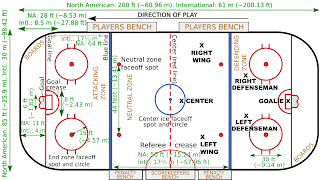Keys to the Power Play
• Win faceoffs
• Enter the zone with speed (look to create chances off
the rush)
• Move the puck low to high or corner to corner – open seams
• Use your PP strategy in the right way to create numerical superiority
• Avoid blocked shots
• If there's traffic in front of the net, look for screens and deflections
• Pursue rebounds with pressure (hold L2 and push RS up)
• Don’t allow yourself to be covered (release to open ice)
All of the above is pretty self explanatory except perhaps for using the right PP strategy. For instance, if you're using the umbrella PP and your opponent does nothing but protect his own net, you will have a hard time getting pucks through close to the crease, as you can see in the example below.
If you want a player behind net, and the PK box is passive, the overload works better, since you get support by the half boards.
However, If the PK plays an aggressive, large box, the umbrella works if you want to find openings in the slot, since the PK tries to put pressure on the PP team outside their slot. This results in them leaving the area around the goal crease open to exploit if their check doesn't work.
This example shows the PK teams aggression better, playing a staggered, large box. Compare the size of their box and their pressure to the PK strategy in the first example.
Now let's go back to the example where the PK team is passive, defending the slot with every man. The best PP strategy for this scenario is to take shots from the point (I use the Shooting PP in the example). Since the opposing team are not leaving the slot I try to make my opponent move a little at least, hoping he will screen his goalie. But as you can see here PK does a great job at clearing the slot (the right thing to do) and they don't get in the way of their goalie. So when I take my first shot, the goalies field of vision is clear and he makes a save. When I take my second shot, though, there's a lot more traffic infront of the net and I score.
Quick puck movement is very important. It makes it harder for the defending team to shift into the right positions, resulting in openings or, as in this case, a D screening his own goalie.
Even if you don't change your PP strategy to the PK's strategy, you can change the way you play. Here's an example on how to get a 2 - 1 facing a diamond PK with a umbrella PP (you're going to need a good passing line to get the pucks through):
Umbrella vs. Diamond














